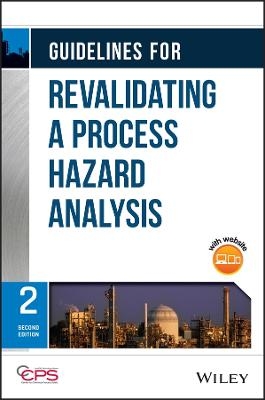
Guidelines for Revalidating a Process Hazard Analysis
Wiley-AIChE (Verlag)
978-1-119-64360-9 (ISBN)
This book is derived from the experience of many companies in the chemical and hydrocarbon processing industries, and presents demonstrated, concise, and common sense approaches for a resource-effective revalidation of process hazard analyses (PHAs). It includes flowcharts, checklists, and worksheets that provide invaluable assistance to the revalidation process.
The new edition, now as a guideline, provides a compete and thorough update of the first book and will provide much needed and requested guidance on PHA Revalidations including evaluating Prior PHA Studies, Identifying an Appropriate Revalidation Methodology, Preparing and Conducting the Revalidation Study Sessions, and Documenting the Revalidation Study.
The Center for Chemical Process Safety (CCPS) has been the global leader in developing and disseminating information on process safety management and technology since 1985. It has published over 100 books in its process safety guidelines and process safety concepts series and created over 30 training modules through its Safety in Chemical Engineering Education series.
List of Tables ix
List of Figures ix
Acronyms and Abbreviations x
Glossary and Nomenclature xii
Acknowledgments xiv
Preface xvi
Dedication xvii
Introduction xix
Objective of this Book xix
Scope of this Book xix
How to Use This Guidelines Book xx
1 Overview of the PHA Revalidation Process 1
1.1 What is a PHA and What is a PHA Intended to Accomplish? 2
1.2 Overview of Typical PHA Activities 4
1.2.1 PHA Core Methodology 4
1.2.2 PHA Complementary Analyses 6
1.3 General Risk Assessment Principles 8
1.3.1 Risk and Risk Tolerance 8
1.3.2 Supplemental Risk Assessments 9
1.4 PHA Revalidation Objectives 11
1.5 PHA Revalidation Concept 14
1.6 PHA Revalidation Cycle 16
1.7 The Role of a PHA Revalidation Procedure 19
1.8 Relationship of RBPS Pillars to a PHA Revalidation 21
2 PHA Revalidation Requirements 23
2.1 External Legal/Regulatory Requirements 23
2.1.1 General Obligations 25
2.1.2 Specific RAGAGEPs 26
2.2 Internal Company Policy Requirements 28
2.2.1 Compliance-Driven Policies 29
2.2.2 EHS-Driven Policies 29
2.2.3 Value-Driven Policies 30
2.3 Internal Company Drivers That Impact Revalidation 31
2.4 Principles for Successful Definition of Revalidation Requirements 33
3 Evaluating the Prior PHA 35
3.1 Prior PHA Essential Criteria 38
3.1.1 Prior PHA Methodology Used 38
3.1.2 Prior PHA Inputs 40
3.1.3 Prior PHA Scope 43
3.1.4 Drawing Essential Criteria Conclusions 46
3.2 Prior PHA Quality and Completeness 48
3.2.1 Application of Analysis Method(s) 49
3.2.2 Level of Detail and Accuracy of the Core Analysis 50
3.2.3 Logic Errors and Inconsistencies in the Analysis 56
3.2.4 Failure to Document Hazards 58
3.2.5 Improper Application of Risk Tolerance 59
3.2.6 Drawing Quality and Completeness Conclusions 60
3.3 Prior PHA Topics for Additional Evaluation 61
3.3.1 Status of Prior PHA Recommendations 61
3.3.2 Complementary Analyses and Supplemental Risk Assessments 62
3.3.3 Opportunity to Learn and Capture Information 62
3.3.4 Continuous Improvement 63
3.3.5 PHA Documentation Software Changes 63
3.3.6 Time Since the Previous Redo 63
3.4 Principles for Successful Prior PHA Evaluation 64
4 Evaluating Operating Experience Since the Prior PHA 67
4.1 Operating Experience Influence on Revalidation 68
4.2 Types of Operating Experience That Should Be Considered 68
4.2.1 MOC and PSSR Records 69
4.2.2 Incident Reports 75
4.2.3 Routine Maintenance Records 77
4.2.4 Audit Results 78
4.2.5 Organizational Changes Not Addressed by MOCs 79
4.2.6 Metrics and Overall Performance 82
4.3 How Operating Experience Affects the Revalidation 83
4.4 Principles for Successful Operating Experience Evaluation 85
5 Selecting An Appropriate PHA Revalidation Approach 89
5.1 Revalidation Approaches 90
5.1.1 Update 90
5.1.2 Redo 92
5.1.3 Combining Update and Redo in a Revalidation 94
5.2 Selecting the Revalidation Options 97
5.2.1 Have the Requirements Changed Significantly? 98
5.2.2 Is the Prior PHA Deficient or Unacceptable? 100
5.2.3 Are There Too Many Changes or Significant Revelations in Operating Experience? 101
5.3 Principles for Successful Revalidation Approach Selection 103
6 Preparing for PHA Revalidation Meetings 105
6.1 Planning the Revalidation Meetings 106
6.1.1 Establishing the Revalidation Scope 106
6.1.2 Selecting Team Members 108
6.1.3 Estimating Schedule, Time, and Resources 110
6.2 Identifying and Collecting Information 113
6.2.1 Determining Information Requirements 113
6.2.2 Distributing Information 117
6.3 Reviewing and Preparing Information 117
6.3.1 Prior PHA Reports and Related Documentation 117
6.3.2 Prior PHA Recommendation Resolution Status 118
6.3.3 MOC and PSSR Records 120
6.3.4 Audit Results 126
6.3.5 Incident Reports 126
6.3.6 Current Piping and Instrument Diagrams 127
6.3.7 Current Operating Procedures 127
6.3.8 Special Considerations for Complementary Analyses and Supplemental Risk Assessments 128
6.4 Principles for Successful Revalidation Preparation 129
7 Conducting PHA Revalidation Meetings 131
7.1 Applying Analysis Methodologies 131
7.1.1 Revalidation of the Core Analysis 132
7.1.2 Revalidation of Complementary Analyses 134
7.1.3 Revalidation of Supplemental Risk Assessments 137
7.2 Facilitating Effective Revalidation Meetings 139
7.2.1 Team Composition 139
7.2.2 Meeting Kickoff 140
7.2.3 Meeting Productivity 143
7.3 Revalidation Meeting Conclusion 149
7.4 Principles for Successful Revalidation Meetings 151
8 Documenting and Following Up on a PHA Revalidation 155
8.1 Documentation Approaches 156
8.2 Report and Its Contents 160
8.3 Recommendations and Follow-Up 161
8.4 Records Retention and Distribution 163
8.5 Principles for Successful Documentation and Follow-Up 165
References 167
Appendices 171
Appendix A Essential Criteria Checklist 171
Appendix B PHA Quality and Completeness Checklist 175
Appendix C Example Change Summary Worksheet 181
Appendix D Checklist of Process, Facility, and Human Factors Changes 183
Appendix E Example Facility Siting Checklists 187
Appendix F Example Human Factors Checklists 199
Appendix G Example External Events Checklist 209
Index 215
| Erscheinungsdatum | 28.10.2022 |
|---|---|
| Sprache | englisch |
| Maße | 158 x 234 mm |
| Gewicht | 386 g |
| Themenwelt | Naturwissenschaften ► Chemie ► Technische Chemie |
| Technik | |
| ISBN-10 | 1-119-64360-0 / 1119643600 |
| ISBN-13 | 978-1-119-64360-9 / 9781119643609 |
| Zustand | Neuware |
| Informationen gemäß Produktsicherheitsverordnung (GPSR) | |
| Haben Sie eine Frage zum Produkt? |
aus dem Bereich



